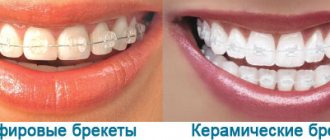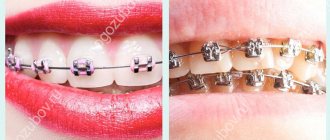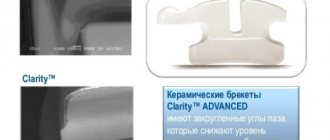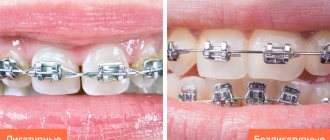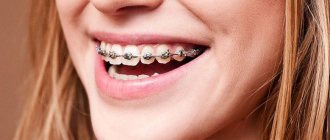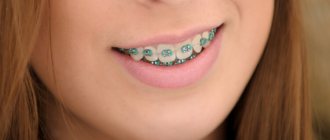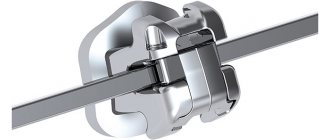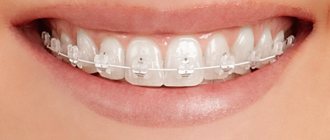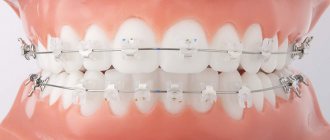Ceramic braces are the most aesthetic multibonding systems, which in their aesthetics are second only to lingual structures. Ceramics are installed on the front surface of the teeth, i.e. The vestibular fixation technique is used, but the locks are almost invisible on the teeth because they are made of transparent materials. The only thing that gives away the orthodontic structure is the metal arch. Manufacturers strive to minimize this factor by painting it white.
Ceramic locks are made from mono- or polycrystals. Products made from polycrystals are slightly inferior in aesthetics due to the admixtures of plastic or metal, which give the lock a slight dullness and opacity. The material for monocrystalline braces is artificial sapphire crystals. They are absolutely transparent and resistant to food coloring, which is why they are most popular.
Aesthetic ceramic braces
Let's start with the fact that ceramic braces are of the vestibular type, that is, they are attached to the outside of the teeth. The color of the design matches any shade of tooth enamel, making it not as noticeable as conventional metal locks. Unlike sapphire braces, ceramic braces do not have the transparency and shine of the latter, but rather have a matte structure that does not transmit light. This fact can rather be considered a plus than a minus, since thanks to it, ceramic dental braces practically merge with the teeth. But brace system manufacturers still have work to do. They are trying to make them more transparent and elegant.
Thus, thanks to the special material, Clarity ceramic braces from 3M Unitek are recognized in orthodontics as one of the most aesthetic systems in the world. They have a natural shade that matches the color of the teeth and do not glare when light hits them. An important advantage of the Mystique bracket system from GAC is that it is made without metal inserts in the bracket body, which disrupt the harmony of appearance of other systems. But the Ormco company, as always, distinguished itself with a non-standard approach to promoting its products, releasing transparent ceramic Damon Clear braces, which are positioned as sapphire systems. Their material has the transparency of sapphire and looks quite aesthetically pleasing on the teeth.
Durability of ceramic braces
In terms of strength, ceramic braces are stronger than sapphire braces, but are definitely inferior to metal ones. Ceramic itself, like sapphire, is quite durable, but is prone to crumble, so braces made from this material require more careful handling and are more difficult to remove than metal systems. But manufacturers are actively coping with these unpleasant shortcomings, introducing new technologies that would help maintain the integrity of the structure and attach more firmly to the tooth enamel.
According to 3M Unitek, the strength of the Clarity SL steel is ensured by the press-in metal groove. They also have a patented hub in the base, which guarantees a secure fit and safe removal. QuicKlear ceramic braces from Forestadent have something similar. They have hook-shaped protrusions with beveled edges, which ensures good adhesion and removal without disturbing the structure. Successful attachment can be achieved using existing anchorage systems. Removal and installation of Ortho Technology's Reflections ceramic brackets are facilitated by a unique dovetail design at the base to maximize the bonding surface. Each ceramic bracket system has its own nuances, but each of them is reliable enough to provide effective treatment.
Differences between white arcs and metal ones
To obtain a white arc, a thin Teflon coating is applied to a standard metal product. It gives the arc some features. Firstly, its diameter increases. Secondly, Teflon increases friction between the archwire and the surface of the braces. These are disadvantages that slightly limit the use of white arcs. Today there is another solution - some manufacturers offer arches in gold and purple shades. This effect is achieved not through coating, but through ion implantation - the metal changes color due to the introduction of impurity atoms into the surface layer of the product. It is carried out by “bombarding” the arc with a flow of ions.
Types of ceramic braces
Today, bracket systems differ not only in the materials from which they are made, but also in the method of fastening. What is the difference between ligature and non-ligature braces? Let's answer this question by analyzing the features of these types of braces.
Ligature
This is a time-tested classic of orthodontic treatment. The name is derived from the Latin word “ligatura”, which means “ligament”. Such brace systems consist of an arch to which clasps are attached using small rings. These are ligatures. There are two types of fastening - elastic bands and wires. The former are used in the initial stages of the procedure or to correct individual teeth, since their pressure on the arch is not strong enough. The latter fix the structure more reliably and are used at the late or final stage of bite correction. Many people note that ligatures scratch the oral mucosa, and sometimes they need to be changed more often than once a month, since the elastic bands can stretch or tear. But one of the advantages is the affordable cost of these braces.
Unligated
Non-ligating or self-ligating braces have appeared relatively recently. Their main feature is that the clasps are attached to the arch using a special mechanism in the form of clips, without elastic rings or wires. Such a system does not require regular correction, and a person can visit the orthodontist much less frequently during treatment. Another positive feature is the smaller size of braces compared to classic ones, which makes the design much more convenient. A significant disadvantage is that the price of self-ligating braces is several times higher than ligature ones. However, both types of fixed appliances perform their main function – correcting the bite – efficiently. Depending on the clinical case, the specialist will help the patient choose the optimal design option.
Installation of ceramic braces
Ligature ceramic braces, however, like all others, consist of locks, rings, an orthodontic arch, ligatures and elastic rods. Their fixation on the teeth is practically no different and consists of several stages:
- First, a bracket is attached to the outer surface of each tooth, which is fixed with a special glue. Before installing ceramic braces, like all others, mandatory sanitation of the oral cavity is carried out: caries is treated, and the patient also undergoes a mandatory professional hygiene procedure.
- After this, all installed locks are connected to each other by orthodontic arches. If ceramic braces are ligature, then the arches are tied to the braces using ligatures.
- Cheek locks and orthodontic rings are attached to several back teeth. If necessary, a metal hook is also installed on which the elastic rod is fixed. It all depends on the evidence.
All this sounds complicated, but in fact, the installation of ceramic braces is quite quick and does not cause any discomfort to the patient. You can choose a dentist for this type of treatment here.
Ceramic braces before and after treatment
Diet features
You also need to reconsider your view of nutrition. You will have to adhere to a strict diet throughout the entire treatment period with ceramic braces:
- It is necessary to exclude hard and crunchy foods - crackers, chips, popcorn, nuts and seeds, as well as hard candies, such as caramel or grilled cake. These products may change the shape of the arc or even cause it to break.
- Sticky and viscous foods are prohibited - cheeses, fresh baked goods, cookies, breakfast cereals, nougat, toffees and others. Of course, chewing gum should be excluded.
- You should be careful with food and drinks that can change the color of the clasps and silicone ligatures. Among them are red wine, black tea and coffee, fruit and vegetable juices, tomatoes, dark berries, chocolate, beets, curry. It is also advisable to limit smoking.
- You should not alternate too hot and cold food; food should be at medium temperature. Frozen berries are strictly prohibited. This contrast can cause the glue that holds the locks to break down.
The basis of the menu can be cream soups, cutlets and meatballs from well-chopped minced meat or fish, mashed potatoes, various cereals, vegetable caviar, milkshakes, smoothies, bananas, watermelons, melons.
Contraindications
Contraindications to installing ceramic braces are the same as for other systems:
- caries and gum disease - first you need to undergo treatment,
- exacerbation of chronic diseases,
- allergies to the materials used,
- numerous fillings and crowns,
- Bruxism is teeth grinding during sleep.
Caution should be exercised when installing braces during pregnancy, as well as for people who engage in extreme and contact sports (boxing, karate, etc.).
How much do ceramic braces cost?
What is the price of ceramic braces in Moscow dentists is of interest to many patients. It is known that it exceeds the price of metal systems. However, the cost of ceramic systems in Moscow is lower than the prices for sapphire or lingual ones. In addition to the material, the price list also depends on the manufacturer of the orthopedic design. Often, when patients find out the price of ceramic braces, clinics use a cunning marketing policy: they announce the amount only for the system and installation (on average this turns out to be from 40,000 to 60,000 rubles), and a person learns about the costs of the treatment itself after the fact. Know that no matter what pricing is used, in the end the average price for ceramic braces for both jaws on a turnkey basis will be around 260,000 rubles.
| Brand | Economy prices | Business prices | Premium prices |
| Clarity SL from 3M Unitek | 130,000 rubles* | 180,000 rubles* | 235,000 rubles* |
| In-Ovation C by GAS | 74,000 rubles* | 120,000 rubles* | 180,000 rubles* |
| QuicKlear from FORSTADENT | 90,000 rubles* | 120,000 rubles* | 180,000 rubles* |
| Damon Clear by Ormco | 70,000 rubles* | 120,000 rubles* | 140,000 rubles* |
* Prices for ceramic braces are indicative for Moscow for 2018. The cost is given taking into account the installation of the system on two jaws and the cost of treatment.
Dentistry "Zuub" - why you need to install it with us
- Only the most modern technologies that are as safe as possible for your teeth.
- Experienced specialists who have repeatedly proven their professionalism in practice.
- Comfortable conditions for each patient, personal approach, responsibility for the result.
- Adequate prices without prescribing unnecessary procedures and services - only what you really need.
- Regular discounts and promotions for significant savings.
- Working with problems of any complexity - we find an approach to every situation.
If you have an incorrect bite, the specialists of the Zuub clinic are happy to offer high-quality services and results that you could only dream of before.
If you have the symptoms described in this article, be sure to make an appointment at our clinic.
Don't self-medicate! Even the smallest problem, if not treated correctly, can significantly complicate your life.
By contacting us, you can be sure that:
- Get high-quality and free consultation .
- You will receive the best prices for treatment and the opportunity to receive a special promotional price.
- Only modern equipment and materials will be used.
- You will be treated by professional doctors with many years of experience.
- We offer treatment on credit or in installments. There is also the possibility of obtaining a tax deduction.
- We work seven days a week and without a lunch break, from 9 a.m. to 10 p.m.
+7 (495) 132-02-96
Make an appointment
How long to wear ceramic braces?
Many patients are interested in how long to wear ceramic braces. The duration of treatment primarily depends on the degree of complexity of the pathology, but wearing ceramic braces may be delayed due to higher friction between the metal arch and the ceramic groove, as well as possible periodic breakdowns of the system. Unlike sapphire devices, which can only be ligature-based, ceramics are also available in non-ligature systems. At the initial stage, the type of brace system may affect the time it takes to achieve the first results, but in general does not affect the time it takes to wear braces.
Adaptation
Getting used to braces varies from person to person.
For some, this process is painful and takes a lot of time, while others note that adaptation was quick and unnoticed.
But on average, the process of getting used to ceramic systems is accompanied by pain of varying intensity in the gums and teeth.
Sometimes the pronunciation of words and the process of chewing food suffer. If a person is determined to achieve a beautiful smile as a result of treatment, getting used to it will take a little time and effort.
Advantages and disadvantages
- Strength - finely divided ceramics, which are baked at high temperatures, are highly resistant to mechanical loads,
- Aesthetics – not visible against the background of teeth,
- Comfort - the small size and smoothness of the braces provide comfortable wearing and quick adaptation, within 3-7 days,
- The disadvantages of ceramic systems include less resistance to high pressure than metal or sapphire, as well as a rather high cost.
Which ceramic braces are better?
Braces systems from different manufacturers have their pros and cons: nuances in treatment and appearance. Today, the most popular systems among patients and in demand among orthodontists are Damon Clear transparent braces. It is not for nothing that they are positioned as sapphire, because they look very similar to sapphire systems, but are free from their drawback - excessive fragility. For a more aesthetic appearance, you can choose the so-called white braces - systems with a white arch (by the way, they are shown in the photo below). Read about all the pros and cons of braces here.
Comparison of different systems
To understand which braces are better and how they differ, let's look at the following table.
| Types of braces systems: | Ceramic | Sapphire | Metal |
| Anomaly complexity | The aesthetic system copes with minor anomalies. | The aesthetic system copes with minor anomalies. | Coping with any anomalies. |
| Duration of treatment | Longer in terms of teeth straightening, 2-3 months longer to wear than metal ones. | The treatment period is not inferior to metal ones. | Fast in treatment due to a firmly controlled arc. |
| Aesthetics | Ceramics are matched to the color of the enamel. | Transparent, white-coated arcs, almost invisible when smiling and talking. | Not aesthetically pleasing, clearly visible on the teeth. |
| Price | Average in cost. | The most expensive. | Available for all patients. |
Rating of ceramic braces according to STARTSMILE
- QuicKlear from FORSTADENT (high aesthetics due to ceramic bracket covers, ideal adhesion to the surface of the teeth due to the presence of reverse hooks on the base.)
- In-Ovation C from GAC (special strength due to zirconium oxide coating, resistance to chemical and temperature influences).
- Damon Clear from Ormco (not subject to staining, quick installation and removal thanks to the patented SPINTEK system).
- Clarity SL from 3M Unitek (invisible on the teeth, as they do not reflect light, the rounded edges of the braces do not injure the mucous membrane).
- Virage from American Orthodontics (high-quality adhesion to the surface of the teeth due to the cellular structure of the base of the braces, metal groove to improve the operation of the system).
- Reflections from Ortho Technology (low profile, most affordable price in its class).
- Crystal from Sia Orthodontic (not susceptible to chipping due to casting and baking at high temperatures, reduced friction due to the special shape of the grooves).
- Experience Ceramic from GC Orthodontics (not conspicuous due to the rhodium coating of the locks, which absorbs light, small size of braces).
- Discovery from Dentaurum (the smallest of all ceramic systems, affordable price).
- Blesk from Smart (high wear resistance due to the material - nanoceramics, low price).
White arcs
Many patients are concerned about the fact that even when using white braces, a metal arch can ruin the whole picture. Today, arcs are made from various alloys:
- Alloy of titanium and nickel (Nitinol);
- Alloy of titanium, nickel and copper;
- Alloy of molybdenum with titanium;
- Titanium alloy with niobile;
- Stainless steel.
Nitinol archwires are the most popular today. They are very flexible and easy to install. To improve aesthetics, the arc is provided with a light coating. Most often it has a white or beige tint. The doctor will select an archwire of a suitable color, taking into account the shade of the teeth. The coating is quite durable and smooth.
Caring for ceramic braces
Modern ceramic systems, for the most part, do not change their color, but plaque that accumulates on their surface is easily stained. Ligatures are also highly susceptible to pigmentation; they can acquire an undesirable tint from black tea or coffee, as well as other colored drinks and foods. In the first case, professional hygienic cleaning using sandblasting machines is recommended, and in the second, you can reassure yourself that the ligatures are changed at every appointment with the orthodontist. And yet, manufacturers want to eliminate such troubles.
Ortho Technology's Reflection ceramic bracket system is made from 99.99% pure polycrystalline aluminum oxide, which is resistant to surface staining or discoloration. Mistique braces from GAS boast similar properties, which are coated with silicon oxide, which does not allow them to absorb dyes and, therefore, do not change color during the treatment process. Ormco also claims that their Damon Clears are made from a pigmentation resistant material. But ligature-free or self-ligating braces such as Clarity 3M Unitek, In-Ovation C from GAS, QuicKlear from FORSTADENT and others will help you avoid staining ligatures. They simply don’t have ligatures and there’s nothing to paint on.
To summarize: if you do not want to show off your orthodontic treatment to others, but are not ready to make serious financial outlays on lingual braces or aligners, ceramic braces are just for you. Ceramics will match any shade of natural teeth and will remain invisible. The aesthetic qualities that ceramic braces have, how much they cost and what comfort they bring to the patient - all this fits into an effective formula for the harmony of price and quality!
